- Home
- Jared Diamond
Upheaval: Turning Points for Nations in Crisis Page 11
Upheaval: Turning Points for Nations in Crisis Read online
Page 11
The result was the Opium War of 1839–1842 between Britain and China, the first serious test of military strength between China and the West. Although China was far larger and more populous than Britain, it turned out that Britain’s navy and army were far better equipped and trained than China’s. Hence China was defeated and forced into humiliating concessions, paying a large indemnity, and signing a treaty that opened five Chinese ports to British trade. France and the U.S. then extracted the same concessions from China.
When the Japanese government learned of these developments in China, it feared that it would be only a matter of time until some Western power demanded a similar treaty port system in Japan. It did happen, in 1853, and the Western power responsible was the U.S. The reason why, among Western powers, the U.S. was the one that became motivated to act first against Japan was the U.S.’s conquest of California from Mexico in 1848, accompanied by the discovery there of gold, which caused an explosion of American ship traffic to the Pacific coast. Sailings of American whaling and trading ships around the Pacific also increased. Inevitably, some of those American ships got wrecked, some of those wrecks occurred in ocean waters near Japan, and some of their sailors ended up in Japan, where they were killed or arrested according to Tokugawa Japan’s isolationist policy. But the U.S. wanted those sailors instead to receive protection and help, and it wanted American ships to be able to buy coal in Japan.
Hence U.S. President Millard Fillmore sent Commodore Matthew Perry to Japan with a fleet of four ships, including two gun-bearing steam-powered warships infinitely superior to any Japanese ships at that time. (Japan had neither steamships nor even steam engines.) On July 8, 1853 Perry sailed his fleet uninvited into Edo Bay (now called Tokyo Bay), refused Japanese orders to leave, delivered President Fillmore’s letter of demands, and announced that he expected an answer when he returned the following year.
For Japan, Perry’s arrival, and his open threat of overwhelming force, conformed to our definition of “crisis”: a serious challenge that cannot be solved by existing methods of coping. After Perry’s departure, the shogun circulated Fillmore’s letter to the daimyo to ask their opinion about how best to respond; that was already unusual. Among their varied proposed responses, common themes were a strong desire to maintain Japan’s isolation, but recognition of the practical impossibility of Japan defending itself against Perry’s warships, hence the suggestion of compromising to buy time during which Japan could acquire Western guns and technology to defend itself. It was the latter view that prevailed.
When Perry returned on February 13, 1854, this time with a fleet of nine warships, the shogun responded by signing Japan’s first treaty with a Western country. Although Japan succeeded in putting off Perry’s demand for a trade agreement, it did make other concessions that ended its 215-year policy of isolation. It opened two Japanese ports as harbors of refuge for American ships, accepted an American consul to reside at one of those ports, and agreed to treat shipwrecked American sailors humanely. After the signing of that agreement between Japan and the U.S., the British and Russian and Dutch naval commanders in the Far East quickly reached similar agreements with Japan.
The 14-year period that began in 1854, when the shogun’s government (called the bakufu) signed Perry’s treaty ending Japan’s centuries of isolation, was a tumultuous period of Japanese history. The bakufu struggled to solve the problems resulting from Japan’s forced opening. Ultimately, the shogun failed, because the opening triggered unstoppable changes in Japanese society and government. Those changes in turn led to the shogun’s overthrow by his Japanese rivals, and then to much more far-reaching changes under the new government that was led by those rivals.
Perry’s treaty and its British, Russian, and Dutch equivalents didn’t satisfy the Western goal of opening Japan to trade. Hence in 1858 the new American consul in Japan negotiated a broader treaty that did address trade, and that was again soon followed by similar treaties with Britain, France, Russia, and the Netherlands. Those treaties became regarded in Japan as humiliating and were termed the “unequal treaties,” because they embodied the Western view that Japan did not deserve to be treated in the way that Western powers treated one another. For instance, the treaties provided for extraterritoriality of Western citizens in Japan, i.e., that they were not subject to Japanese laws. A major goal of Japanese policy for the next half-century became the undoing of the unequal treaties.
Japan’s military weakness in 1858 relegated that goal to the distant future. Instead, the bakufu’s more modest immediate goal in 1858 was to minimize the intrusion of Westerners, and of their ideas and influence. That was achieved by Japan’s keeping up the fiction of obeying the treaties, while actually frustrating them by delaying, unilaterally changing agreements, taking advantage of Western unfamiliarity with ambiguous Japanese place names, and playing off different Western countries against one another. Through the 1858 treaties, Japan succeeded in limiting trade to just two Japanese ports, termed “treaty ports,” and in restricting foreigners to specified districts within those ports beyond which foreigners were forbidden to travel.
The bakufu’s basic strategy from 1854 onwards was one of buying time. That meant satisfying Western powers (with as few concessions as possible), but in the meantime acquiring Western knowledge, equipment, technology, and strength, both military and non-military, so as to be able to resist the West as soon as possible. The bakufu, and also the powerful domains of Satsuma and Choshu4 that were nominally subject to the bakufu but enjoyed much autonomy, purchased Western ships and guns, modernized their militaries, and sent students to Europe and the U.S. Those students studied not just practical matters such as Western navigation, ships, industry, engineering, science, and technology, but also Western laws, languages, constitutions, economics, political science, and alphabets. The bakufu developed an Institute for the Study of Barbarian (i.e., foreign) Books, translated Western books, and sponsored the production of English-language grammars and an English pocket dictionary.
But while the bakufu and the big domains were thus trying to build up strength, problems resulting from Western contact were developing in Japan. The bakufu and domains became heavily indebted to foreign creditors as a result of expenses such as weapons purchases and sending students overseas. Consumer prices and the cost of living rose. Many samurai (the warrior class) and merchants objected to the bakufu’s efforts to monopolize foreign trade. Now that the shogun had asked the daimyo for advice after Perry’s first visit, some daimyo wanted to become further involved in policy and planning, rather than leaving it all to the shogun as before. It was the shogun who had negotiated and signed treaties with Western powers, but the shogun couldn’t control outlying daimyo who violated those treaties.
The result was several sets of intersecting conflicts. Western powers were in conflict with Japan about whether to open Japan more (the Western goal) or less (the prevalent Japanese goal) to the West. Domains such as Satsuma and Choshu, which had already traditionally been in conflict against the bakufu, were now in sharper conflict, each side trying to use Western equipment and knowledge and allies against the other. Conflicts increased between domains. There was even conflict between the bakufu and the figurehead emperor at the imperial court, on whose behalf the bakufu supposedly acted. For instance, the imperial court refused to approve the 1858 treaty that the bakufu had negotiated with the U.S., but the bakufu proceeded to sign it anyway.
The sharpest conflict within Japan arose over Japan’s basic strategy dilemma: whether to try to resist and expel the foreigners now, or instead to wait until Japan could become stronger. The signing of the unequal treaties by the bakufu created a backlash in Japan: anger at the foreigners who had dishonored Japan, and anger at the shogun and other lords who had permitted Japan to be dishonored. Already around 1859, resentful, hotheaded, naïve young sword-wielding samurai began to pursue a goal of expelling foreigners by a campaign of assassination. They became known as “shishi,” meaning “men of h
igh purpose.” Appealing to what they believed were traditional Japanese values, they considered themselves morally superior to older politicians.
The following statement of shishi principles, issued in 1861, conveys the flavor of their anger: “It is a source of deepest grief to our Emperor that our magnificent and divine country has been humiliated by the barbarians, and that the Spirit of Japan, which was transmitted from antiquity, is on the point of being extinguished.… It is said that, when one’s lord is humiliated, his retainers must choose death. Must we not set even greater emphasis on the present situation, in which the Imperial Country is about to know disgrace?… We swear by our deities that, if the Imperial Flag is once raised, we will go through fire and water to ease the Emperor’s mind, to carry out the will of our former lord, and to purge this evil from our people. Should any, in this cause, seek to put forward personal considerations, he shall incur the punishment of the angered gods, and be summoned before his fellows to commit hara-kiri.”
Shishi terrorism was directed against foreigners, and even more often against Japanese working for or compromising with foreigners. In 1860 a group of shishi succeeded in beheading the regent Ii Naosuke, who had advocated signing treaties with the West. Japanese attacks against foreigners climaxed in two incidents in 1862 and 1863 involving the domains of Satsuma and Choshu. On September 14, 1862 a 28-year-old English merchant, Charles Richardson, was attacked by Satsuma swordsmen on a road and left to bleed to death, because he was considered to have failed to show proper respect for a procession that included the father of Satsuma’s daimyo. Britain demanded indemnities, apologies, and execution of the perpetrators not only from Satsuma but also from the bakufu. After nearly a year of unsuccessful British negotiations with Satsuma, a fleet of British warships bombarded and destroyed most of Satsuma’s capital of Kagoshima and killed an estimated 1,500 Satsuma soldiers. The other incident occurred in late June 1863, when Choshu coastal guns fired on Western ships and closed the crucial Shimonoseki Strait between the main Japanese islands of Honshu and Kyushu. A year later, a fleet of 17 British, French, American, and Dutch warships bombarded and destroyed those coastal guns and carried off Choshu’s remaining cannon.
Those two Western retaliations convinced even Satsuma and Choshu hotheads of the power of Western guns, and of the futility of Japan’s attempting to expel the foreigners while in its current weak condition. The hotheads would have to wait until Japan had achieved military equality with the West. Ironically, that was the policy that the bakufu had already been following, and for which the hotheads had been excoriating the bakufu.
But some domains, especially Satsuma and Choshu, were now convinced that the shogun was incapable of strengthening Japan to the point where it could resist the West. The daimyo concluded that, while they shared the bakufu’s goal of acquiring Western technology, achieving that goal required reorganizing Japan’s government and society. Hence they sought gradually to outmaneuver the shogun. Satsuma and Choshu had formerly been rivals, had been suspicious of each other, and had fought against each other. Recognizing that the shogun’s efforts to build up military strength threatened both domains, they now formed an alliance.
After the former shogun’s death in 1866, the new shogun launched a crash program of modernization and reform, including importing military equipment and military advisors from France. That increased the perceived threat to Satsuma and Choshu. When the former emperor also died in 1867, his 15-year-old son succeeded to the imperial throne (Plate 3.2). Satsuma and Choshu leaders conspired with the new emperor’s grandfather and thereby enlisted the support of the imperial court. On January 3, 1868 the conspirators seized the gates of the Imperial Palace in the city of Kyoto, convened a council stripping the shogun of his lands and of his position on the council, and ended the shogunate. The council proclaimed the fiction of “restoring” the responsibility for governing Japan to the emperor, although that responsibility had previously actually been the shogun’s. That event is known as the Meiji Restoration, and it marks the beginning of what is termed the Meiji Era: the period of rule of the new emperor.
After that coup gave them control of Kyoto, the immediate problem facing the Meiji leaders was to establish control over all of Japan. While the shogun himself accepted defeat, many others did not. The result was a civil war between armies supporting and armies opposing the new imperial government. Only when the last opposition forces on Japan’s northern main island of Hokkaido had been defeated in June 1869 did foreign powers recognize the imperial government as the government of Japan. And only then could Meiji leaders proceed with their efforts to reform their country.
At the beginning of the Meiji Era, much about Japan was up for grabs. Some leaders wanted an autocratic emperor; others wanted a figurehead emperor with actual power in the hands of a council of “advisors” (that was the solution that eventually prevailed); and still another proposal was for Japan to become a republic without an emperor. Some Japanese who had come to appreciate Western alphabets proposed that alphabets replace Japan’s beautiful but complex writing system, consisting of Chinese-derived characters combined with two Japanese syllabaries. Some Japanese wanted to launch a war against Korea without delay; others argued for waiting. The samurai wanted their private militias to be retained and used; others wanted to disarm and abolish the samurai.
Out of this turmoil of conflicting proposals, the Meiji leaders decided soon in favor of three basic principles. First, although some of the leaders had been among the hotheads who wanted immediately to expel Westerners, realism quickly prevailed. It became as clear to Meiji leaders as it had been to the shogun that Japan was presently incapable of expelling Westerners. Before that could be done, Japan had to become strong by adopting Western sources of strength, meaning not just guns themselves but also far-reaching political and social reforms that provided the underpinnings of Western strength.
Second, an ultimate goal of Meiji leaders was to revise the unequal treaties that had been imposed upon Japan by the West. But that required Japan to be strong and to be seen by the West as a legitimate Western-style state, with a Western-style constitution and laws. For example, Britain’s foreign secretary, Lord Granville, bluntly told Japanese negotiators that Britain would recognize Japanese “jurisdiction over British subjects [resident in Japan] in precise proportion to their [Japanese] advancement in enlightenment and civilization,” as judged by Britain according to British standards of advancement. It ended up taking 26 years from the Meiji coup until the time when Japan could get the West to revise the unequal treaties.
The third basic principle of Meiji leaders was to identify, adopt, and modify, in each sphere of life, the foreign model that was best matched to Japanese conditions and values. Meiji Japan variously borrowed especially from British, German, French, and American models. Different foreign countries ended up as models in different spheres: for instance, the new Japanese navy and army became modeled on the British navy and the German army, respectively. Conversely, within a given sphere, Japan often tried a succession of different foreign models: for example, in creating a Japanese civil law code, the Justice Ministry relied on a French scholar to produce a first draft, and then turned instead to a German model for the next draft.
Meiji Japan’s borrowing from the West was massive, conscious, and planned. Some of the borrowing involved bringing Westerners to Japan: for instance, importing Western schoolteachers to teach or to advise on education, and bringing two German scholars to help write a Japanese constitution drawing heavily on Germany’s constitution. But more of the borrowing involved Japanese traveling as observers to Europe and the U.S. A crucial step, undertaken just two years after the Meiji government had consolidated its power, was the Iwakura Mission of 1871–1873 (Plate 3.3). Consisting of 50 government representatives, it toured the U.S. and a dozen European countries, visited factories and government offices, met U.S. President Grant and European government leaders, and published a five-volume report providing Japan with de
tailed accounts of a wide range of Western practices. The mission announced its purpose as being “to select from the various institutions prevailing among enlightened nations such as are best suited to our present condition.” When war broke out between France and Prussia in 1870, Japan even sent two observers with a much narrower purpose: to watch first-hand how Europeans fought.
A by-product of these foreign travels was that Japanese with overseas experience tended to become Meiji Japan’s leaders, both in government and in private spheres. For example, of the two most important younger men who rose to power in the Meiji government in the 1880’s, Ito Hirobumi (who led the design of Japan’s new constitution) had made several long visits to Europe, while Yamagata Aritomo (who became prime minister) had studied military science in Germany. Godai Tomoatsu used his European experience to become president of Osaka’s chamber of commerce and a Japanese railroad and mining entrepreneur, while Shibusawa Eiichi (financial comptroller of an 1867 Japanese mission in Paris) went on to develop Japanese banking and textile industries.
In order to make this massive borrowing from the West palatable to Japanese traditionalists, innovations and borrowings in Meiji Japan were often claimed to be not new at all, but just returns to Japan’s traditional ways. For example, when the emperor himself in 1889 promulgated Japan’s first constitution, based heavily on the German constitution, in his speech he invoked his ascent “to the Throne of a lineal succession unbroken for ages eternal,” and “the right of sovereignty of the State [that] we have inherited from Our Ancestors.” Similarly, new rituals invented for the imperial court during the Meiji Era were claimed to be timeless old court rituals.

 Why Is Sex Fun?: The Evolution of Human Sexuality
Why Is Sex Fun?: The Evolution of Human Sexuality Guns, Germs, and Steel: The Fates of Human Societies
Guns, Germs, and Steel: The Fates of Human Societies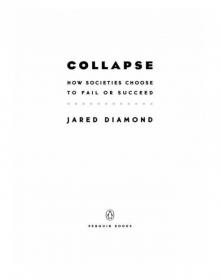 Collapse: How Societies Choose to Fail or Succeed
Collapse: How Societies Choose to Fail or Succeed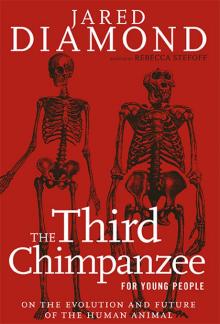 The Third Chimpanzee: The Evolution and Future of the Human Animal
The Third Chimpanzee: The Evolution and Future of the Human Animal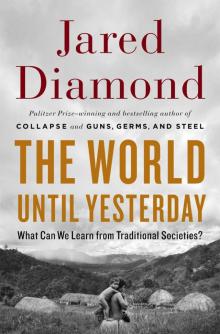 The World Until Yesterday: What Can We Learn From Traditional Societies?
The World Until Yesterday: What Can We Learn From Traditional Societies?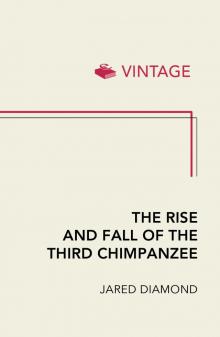 The Rise and Fall of the Third Chimpanzee
The Rise and Fall of the Third Chimpanzee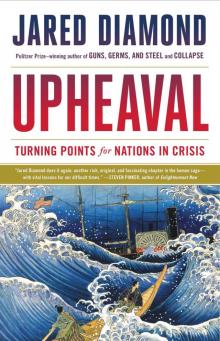 Upheaval: Turning Points for Nations in Crisis
Upheaval: Turning Points for Nations in Crisis Guns, Germs, and Steel
Guns, Germs, and Steel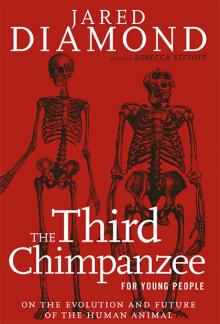 The Third Chimpanzee for Young People
The Third Chimpanzee for Young People Why Is Sex Fun?
Why Is Sex Fun?